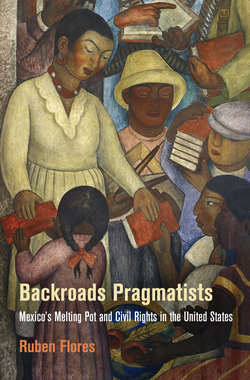Backroads Pragmatists

Реклама. ООО «ЛитРес», ИНН: 7719571260.
Оглавление
Ruben Flores. Backroads Pragmatists
Отрывок из книги
Backroads Pragmatists
Series Editors
.....
The same set of documents in which Sánchez and Embree discussed Rivera’s mural images also captured their interest in Mexico’s state-led policy projects for achieving the harmonious society. Sánchez had come to Mexico in 1935, two years into the massive reorganization of government Franklin D. Roosevelt initiated in 1932. And yet, during the quintessential episode in the growth of the American federal state, it was not the New Deal that represented the archetype of the activist state for George Sánchez. When he returned from Mexico in 1935, it was Mexico’s central state growth after 1920 that he celebrated for its postrevolutionary ‘new deal’ efforts, not that of the United States.41 Edwin Embree had long been involved in the Rosenwald Fund project to build schools for Blacks in the American Deep South. But Mexico’s public mechanism for constructing educational institutions in rural Mexico provided a novel model for thinking about the role of public government in modern society rather than that of private philanthropy.42 For these Americans, Rivera’s images had provided proof that the United States was not alone in conceiving of itself as a society of disparate cultures needing to be fused into a common whole. But those images functioned primarily as symbols of a monumental government attempt to harness the power of the central state in the pursuit of social reform, not as images of the romantic racial utopia.
The history of state involvement in the relationship between the Europeans who colonized Mexico and the native Americans they encountered there was not original to the postrevolutionary writings of Vasconcelos, Gamio, and Sáenz. Such thought has always been one of the dominant strands in Mexican intellectual history. In his assessment of the differences between social projects that came before and after the revolution, for example, Mexican philosopher Luis Villoro traced a line of antecedent projects that had attempted to merge Mexico’s indigenous cultures into the life of the nation-state as far back as the sixteenth century.43 Hernán Cortés, Fray Bernardino de Sahagún, Francisco Javier Clavijero, Fray Servando Teresa de Mier, and Manuel Orozco y Berra—these and more had all attempted to reformulate the relationship of Mexico’s native Americans to the European power structures established by the Spanish invaders.44 These ideas about the relationship between the Indian and the European were a broad spectrum of models that stretched as far back in Mexican history as one cared to look, Villoro argued. One important precursor to postrevolutionary thought about the relationship of Mexico’s peoples to one another that had been reached in the late nineteenth century, for example, when the Porfirian era work of Francisco Pimentel, Francisco Bulnes, and Andrés Molina Enríquez had reformulated the Native American from a novelty to an integral sociological unit of the Mexican nation. “Before we were interested in the Indian as a relic of the past, as a tradition. But now he has been configured as a vital element of our national character,” wrote Villoro. “The Indian is now considered to be a living, breathing factor in our social life, an input into our nation whose efficient contribution we are all now in search of.”45 Operating from the vantage point of 1900, when the view of Mexican history seemed only to magnify Mexico’s military and economic weaknesses before the growth of the United States, Villoro wrote, Pimentel and others had accepted the assumption that only a reconfigured relationship of Mexico’s people to one another could produce a strong nation capable of withstanding foreign military power. While they stopped short of giving Indians autonomy within the nation, they nonetheless triumphed Native Americans as integral to fin de siècle Mexico. “A nation is an assemblage of men who share a common set of beliefs, who are guided by a single idea, and who labor toward the same goal,” wrote Pimentel in 1864. “So long as our Indians are segregated as they are today, Mexico cannot reach the rank of true nationhood.”46
.....